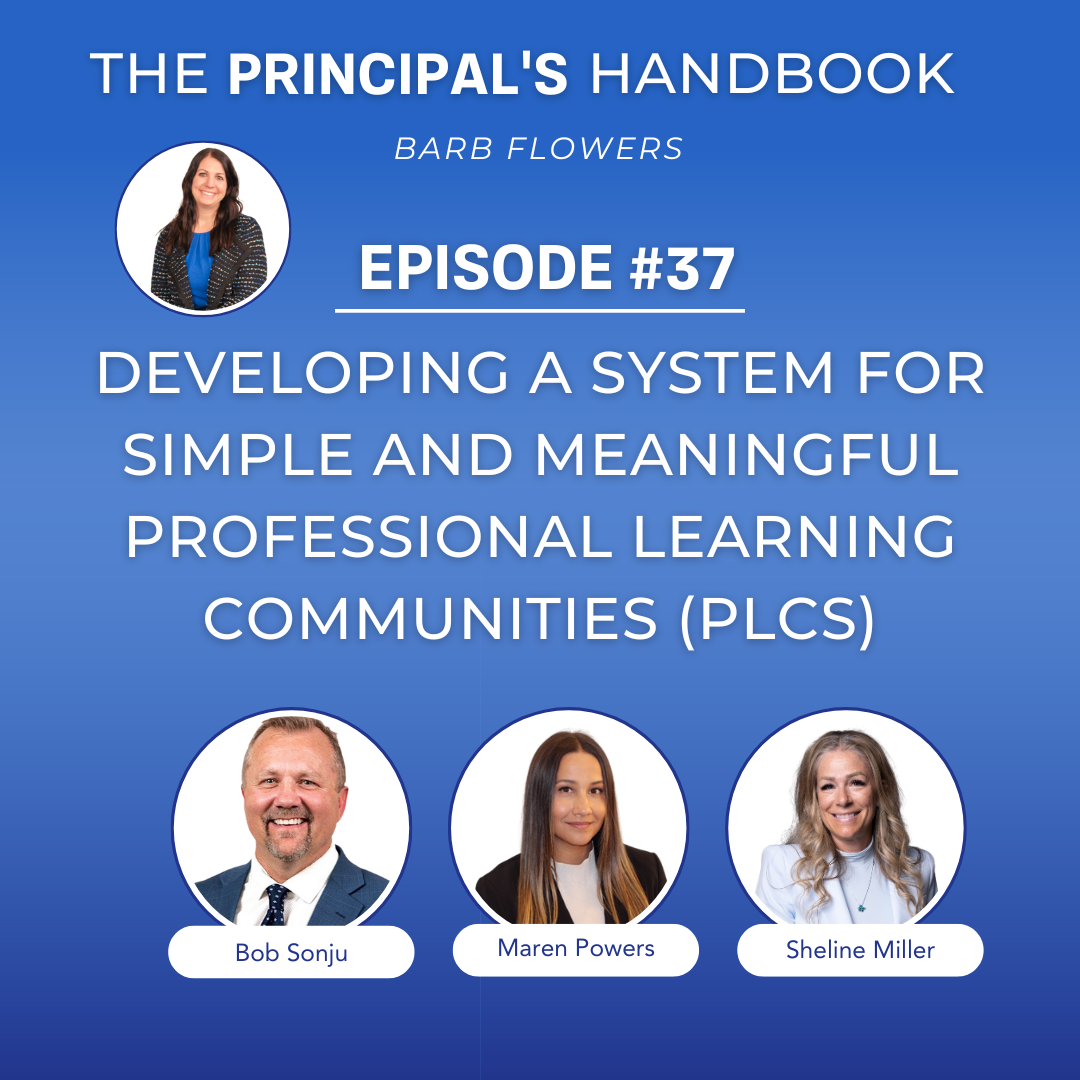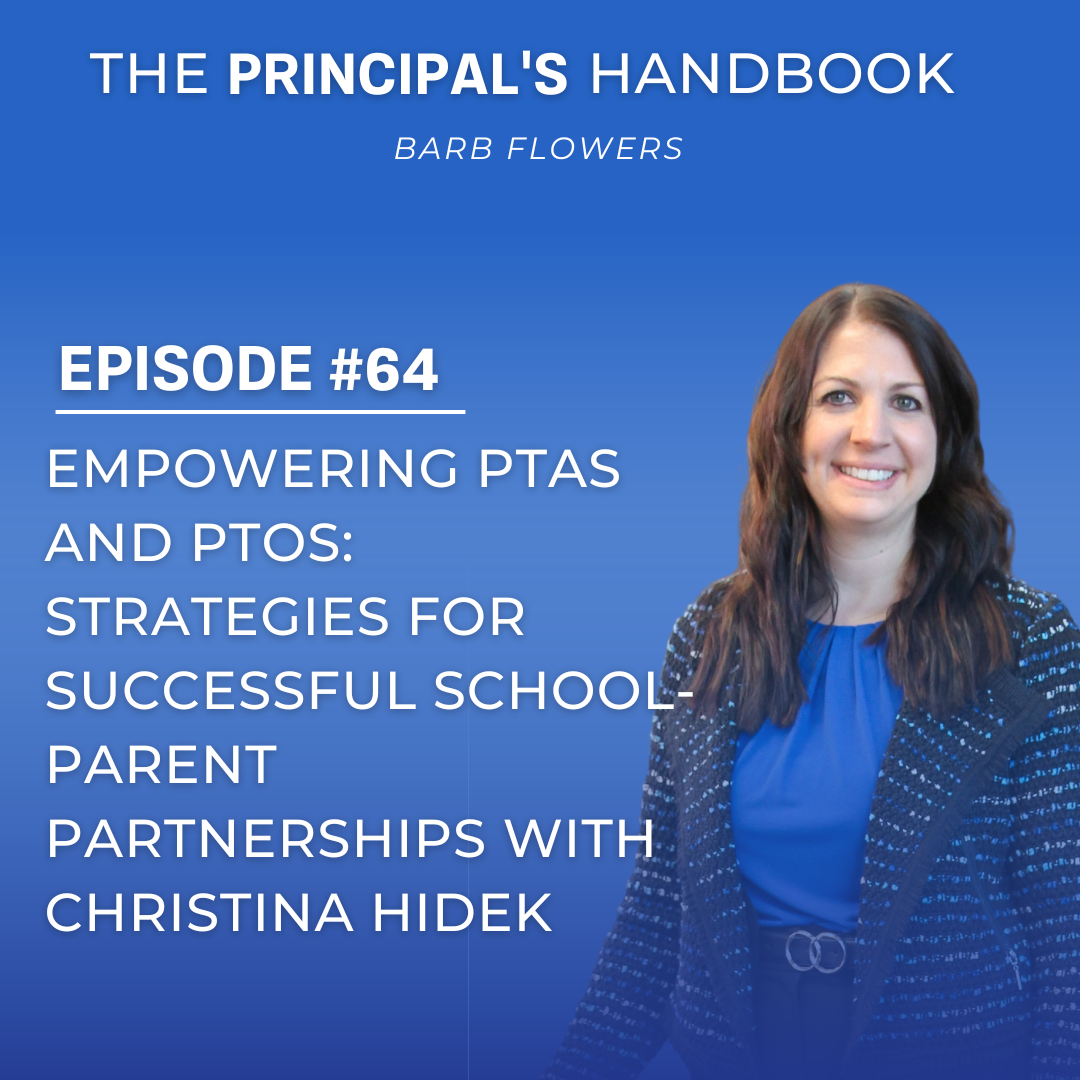[00:00:00]
Barb:
Welcome to The Principal’s Handbook, your go-to resource for principals looking to revamp their leadership approach and prioritize self-care. I’m Barb Flowers, a certified life coach with eight years of experience as an elementary principal. Tune in each week as we delve into strategies for boosting mental resilience, managing time effectively, and nurturing overall wellness.
From tackling daily challenges to maintaining a healthy work-life balance, I’m here to help you navigate the complexities of school leadership. Join me in fostering your sense of purpose as a principal and reigniting your passion for the job. Welcome to a podcast where your well-being is the top priority.
Barb:
Welcome everyone to The Principal’s Handbook. I’m so excited today because I have some amazing guests joining me—Bob Sonju, Maren Powers, and Shaleen Miller. They’re here to talk about their book Simplifying the Journey: Six Steps to Schoolwide Collaboration, Consistency, and Clarity in a PLC at Work.
Thanks so much for being here!
Guests:
Great to be here. Thanks for having us. We’re excited to talk with you.
Barb:
Let’s start with introductions. Tell us a bit about yourselves and what led you to this work around PLCs.
Bob:
I’m Bob Sonju, and I’m a career educator. I’ve been in education for about 35 years—as a teacher at all levels, administrator, district leader, and consultant. For the past 15 years, I’ve worked with schools across the country helping them implement PLCs.
Maren:
I’m Maren Powers. I guess I’m the newbie—I’ve been in education for eight years. I’m currently an instructional coach and was an English teacher before that. I started my career in a model PLC school, and I’ve been doing this work ever since. I’m also a Solution Tree associate and work with schools nationwide.
Shaleen:
I’m Shaleen Miller. I’ve spent many years in the classroom and helped develop several model PLC schools. I’ve worked as a learning coach and recently stepped into administration. I wrote this book from the perspective of a coach and teacher—and now I’m excited to implement it as a leader, too.
Barb:
I love the mix of perspectives here—a principal, a coach, and a teacher. That’s so valuable. Let’s dive in. Your book is all about simplifying PLCs. Sometimes PLCs feel overwhelming or ineffective. How can principals simplify the process and make it more impactful?
Bob:
Great question. First, we have to stop thinking of PLCs as “professional paperwork communities” or “perfection communities.” The “L” stands for learning, specifically adult learning. Students learn more when the adults get better.
Too often, schools wait until everything is “perfect” before they start. We wrote this book to simplify the process by breaking it down into actionable steps tied to the four key questions that drive PLCs. For principals, we outline four steps for leading this work:
-
Clarify the Work: Be clear about what collaboration should look like. It’s not just “go collaborate”—you need to define what that means.
-
Support the Work: Provide time, resources, and coaching so teachers can learn and grow together.
-
Monitor the Work: Not micromanage, but truly check in and observe. Know where teams are strong and where support is needed.
-
Validate and Celebrate: Don’t forget to acknowledge progress. Celebrate the learning, not just the results.
Barb:
I love that last step—celebrating! We don’t do that enough in education. We’re always focused on what’s next instead of what’s going well.
Maren:
Exactly. And for team leads, it’s the same steps—just on a smaller scale. Whether you’re leading a grade level or working as a coach, those steps still apply.
Shaleen:
And when we talk about support, it’s not just cheerleading. Real support means giving PD, time, and the right tools. Teachers can’t do everything at once—we have to focus, build muscle memory, and shift from doing it because the principal said so to doing it because it’s who we are.
Barb:
That’s a great point. Do you recommend that coaches attend PLCs? Or should PLCs request support from them?
Shaleen:
It depends on where the team is. Some teams will know exactly what they need and will reach out. Others will need more guidance. Coaches can provide that, especially early on. Eventually, teams start owning the process and leading themselves.
Barb:
What’s the biggest mistake schools make when implementing PLCs?
Bob:
I’d say two things:
-
Treating PLCs as a program instead of a process. They’re not the latest initiative—they’re a way of doing business.
-
Treating PLCs like a checklist. Laminating essential standards and calling it done misses the point. This work is about learning together. Identifying standards and reviewing assessments is just the beginning—it’s what we learn from doing those things that matters.
Shaleen:
And you don’t have to throw out everything you’re already doing. Teachers are doing great things—this just helps align and elevate that work.
Maren:
Yes! And clarity is key. Clear expectations from the principal, clear communication within teams, and a clear purpose all go a long way toward avoiding initiative fatigue.
Barb:
That’s so important. I’ve seen PLC time turn into planning field trips because there’s no structure or clarity. What role does goal-setting play in keeping PLCs on track?
Shaleen:
It’s essential. Big, vague goals like “We’re going to collaborate” don’t help. Specific goals with clear timelines and success criteria allow teams to reflect, adjust, and improve.
Bob:
Exactly. We wanted this book to be simple and doable. Each chapter ends with actionable steps, questions for reflection, and even administrator prompts for monitoring the work. Like in our chapter on collaboration—we don’t just say “collaborate.” We outline exactly what that looks like and provide guiding questions for teams and leaders.
Barb:
I love that. When I created time for PLCs in my school, I always reminded teachers we were giving up instructional minutes—so we needed to make the most of it.
Maren:
That ties perfectly into how the book started. During COVID, our school kept moving forward because we had these processes in place. Once things settled, we realized how powerful this system was—and how much other schools could benefit from something simple and effective.
Barb:
That makes so much sense. So let’s say a principal is listening and their school hasn’t started any PLCs yet. What should they do first?
Bob:
Three key things:
-
Clarify Your Purpose: Why does your school exist? In a PLC, the answer is “to ensure all students learn at high levels.”
-
Build a Guiding Coalition: Shared leadership is crucial. It can’t be just the principal driving the work.
-
Establish a Framework: Use the six steps in the book to guide the process. They provide the rails for this important work.
Remember: simple doesn’t mean easy. This is deep, cultural work. But it’s the right work.
Barb:
Yes—changing school culture is hard. You need a foundation of trust, vulnerability, and shared responsibility. That’s not always easy.
Shaleen:
Exactly. Collaboration requires humility. It’s not just about celebrating wins—it’s about being willing to say, “That lesson bombed. Help me figure it out.”
Maren:
We included a “Don’t Miss This” section at the end of each chapter with ways to address common roadblocks. Whether it’s a team that doesn’t get along or a group of new teachers, there are practical strategies to help.
Shaleen:
And throughout the book, we provide ideas for how to help teams find shared clarity—even when there’s disagreement on what proficiency looks like or which standards are essential.
Maren:
We’ve seen these steps work in schools all across the country. When teams follow the framework, things start to click. They see each other’s perspectives, and the work becomes more cohesive.
Barb:
That’s such a helpful resource. And let’s be honest—collaboration is messy. There will be roadblocks.
What final thoughts do you have for principals listening today?
Shaleen:
PLCs don’t happen in a year. It’s a continuous cycle of learning and improvement. You won’t be great right away—and that’s okay. Each cycle helps you get better.
Barb:
That’s so true. I remember wanting full implementation in one year—but it’s long-term work. When we accept that, it becomes more manageable.
Bob:
Exactly. The goal isn’t to become a PLC. The goal is to ensure high levels of learning for all students. PLCs are the process we use to get there.
Maren:
And just to echo that, we are practitioners. We’ve done this work ourselves. This book was written by educators for educators. It’s simple, doable, and designed to help everyone in the building—from principals to team leads to classroom teachers.
Barb:
Thank you so much, Bob, Maren, and Shaleen. This was such a valuable conversation. I’ll link to the book and your contact information in the show notes so listeners can reach out if they’d like to connect.
And thank you to all of you for tuning in to The Principal’s Handbook. See you next time!






